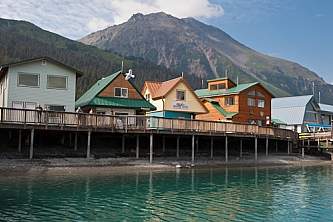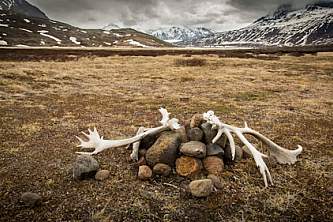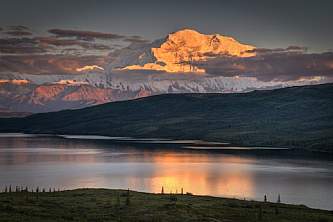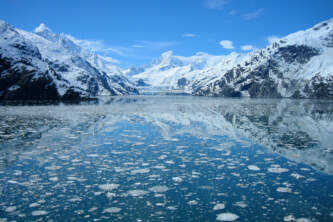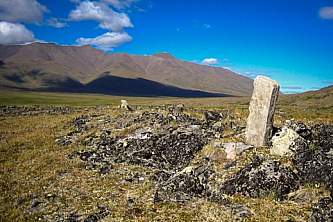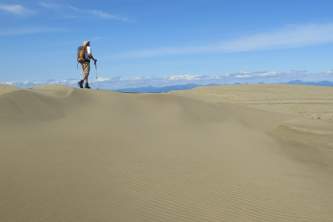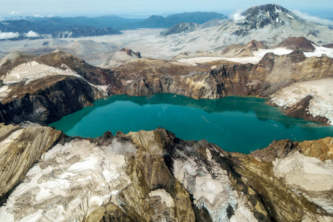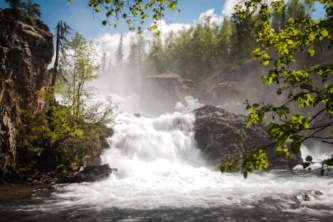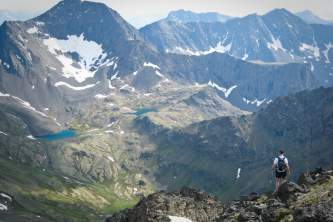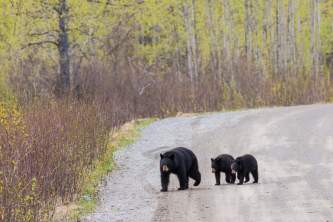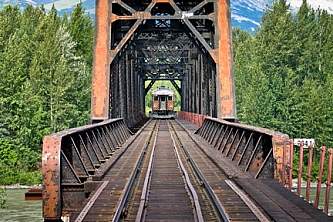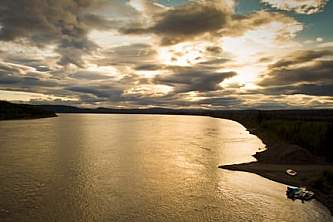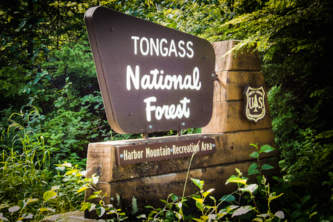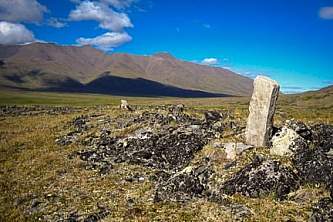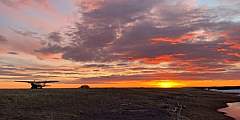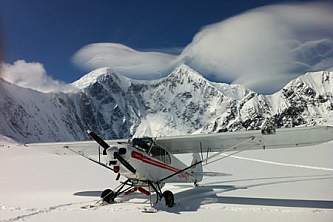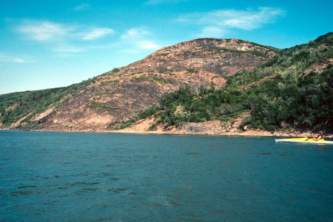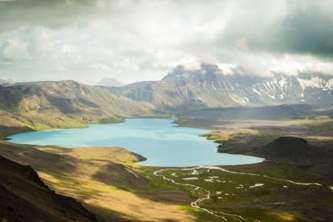Alaska has 60% of all land managed by the National Park Service, even better, some of this parkland is relatively easy to reach. But remember, when planning, be realistic—Alaska is huge.
Alaska's National Parks & Public Lands
Getting Around
3 National Parks are accessible by road; Denali, Kenai Fjords, and Wrangell St. Elias. The other 5 require a boat or air taxi.Little Known Fact
Katmai and Lake Clark are only accessible by plane, but you can easily get there by booking a bear viewing day trip from Anchorage.Here’s an overview of what you need to know.
Alaska’s 4 Most Popular And Accessible Parks
Alaska’s most-visited national parks are the ones most accessible from the road system or on a cruise. They have convenient accommodations nearby and well-developed tours that make exploring easier for the casual visitor.
Denali National Park
Getting There: 5-hour drive/8-hour train ride from Anchorage; 3-hour drive/4-hour train ride from Fairbanks.
Time: At least 3 days: 2 to get there and back, and another to explore the park.
How to do it: Personal vehicles aren’t allowed past the 15-mile mark of the 93-mile park road. Plan to take a bus tour, because you’ll want to go farther than that. Tours range from 6.5–13 hours round-trip, and offer the spectacle of endless vistas, glorious peaks, and of course the chance to see wildlife like brown bear, moose, caribou, Dall sheep, and moose. Or ride the park shuttle bus, which lets you hop on and off to hike. This option often makes you feel like you have Denali to yourself, you may not even see another person until the bus comes back to pick you up. Another option: overnight at a campground or backcountry lodge. Whichever you choose, Denali makes it easy to feel like you’re in remote Alaska. See all park tours.
Kenai Fjords National Park
Getting There: 2.5-hour drive/4-hour train ride south of Anchorage.
Time: You can do a long day trip from Anchorage, but try to allot two days.
How to do it: A day cruise is the most popular way to see the park: You’ll find calving glaciers, steep cliffs along the shoreline, seabirds, and chances to spot whales and other marine mammals. If you have more than a day, a multi-day small boat or yacht cruise allows you to really experience the area. You can kayak from the boat, linger in front of glaciers, and go ashore for hikes. The only part of the park you can get to by car is Exit Glacier. Walk right up to its face, or plan a longer hike to overlook the vast Harding Ice Field. See all park tours.
Wrangell-St. Elias National Park
Getting There: To the town of McCarthy inside the park, it’s about a 7-hour drive from Anchorage and a 9-hour drive from Fairbanks
Time: At least 3 days: 2 to get there and back, and another to explore the park.
How to do it: You have 2 route options—both primitive. First is the more popular McCarthy Road, which takes you to the charming community of McCarthy. Walk across the footbridge (no vehicles allowed in town), and there’s typically a shuttle a shuttle to Kennicott —a thriving mining town abandoned long ago. In addition to touring the mine, popular activities include guided glacier hikes, flightseeing, and rafting. Your second option to reach the national park is via the Nabesna Road, on the park’s north edge, a 42-mile journey where you may not see another soul. Also a mining road, the Nabesna follows a valley between two mountain ranges, with some trails and a campground along the way. Stop to fish in the lakes, hike up a volcano, and enjoy the panorama of the Wrangells—as entrancing a view as any other in the state.
Note: Most rental car companies do not allow their vehicles on these gravel roads. These companies do: Alaska 4x4 Rentals, Alaska Auto Rentals.
Glacier Bay National Park
Getting There: This park may be on your cruise itinerary; if not, you’ll need to fly or ferry to Gustavus (easy to do from Juneau) where you can book a day cruise.
Time: If you’re on your own, spend one day cruising Glacier Bay, and add one or two more days for activities like a ranger-led hike or sea kayaking.
How to do it: Massive, calving tidewater glaciers and marine wildlife are the main draws here. Floating through a sea of small icebergs, you can hear the creaking of active glaciers, with potential for huge chunks of ice to fall splashing into the bay.
More Remote Parks
The rest of Alaska’s national parks are accessible by air; some feature lodges that span the range from rustic to luxurious and offer plenty of opportunities for real wilderness exploration. If you’re pressed for time, some parks make for an easy day trip from Anchorage or Fairbanks.
Katmai National Park
Getting There: Floatplane from Anchorage or Homer
Time: Day trip for bear viewing, longer for other Valley of Ten Thousand Smokes
How to do it: Katmai famous for the large brown bears that converge to feed on salmon at Brooks Falls; go in June and July to spend a magical day there. Or stay for a few days and add a tour into the Valley of Ten Thousand Smokes, site of the 20th-century’s largest volcanic eruption. A 1.5-hour bus ride splashes through creek beds and up to a view over miles of ash stretching toward distant volcanoes. Then hike down 800 feet to the valley floor, where the river has cut a ravine into ash and rock.
Lake Clark National Park
Getting There: Floatplane from Anchorage or Homer
Time: Day trip for bear viewing, longer to stay at a lodge
How to do it: Lake Clark offers bear viewing in an undeveloped area with fewer visitors. Here, coastal brown bears dig for clams or fish for salmon along the shore. Or head inland to visit Dick Proenneke’s hand-built cabin and spend a fascinating day learning how he survived and thrived in the wilderness for decades.
Gates of the Arctic National Park
Getting There: 1.5-hour flight from Fairbanks
Time:
How to do it: Here you’ll find even more remoteness, with no amenities or cell service. The wide-open tundra makes it easy to hike for miles here. Visit the small native village of Anaktuvuk Pass to get a sense of life in the north, or plan a float trip on one of six Wild and Scenic Rivers.
Big-Budget
Other remote national parks and preserves can be challenging to visit, requiring more time, a flexible schedule, and a budget that can cover charter flights and backcountry guides. You’ll find no services of any kind; if you don’t have backcountry experience, we can recommend guides who will take you or show you the ropes so you can go on your own.
Kobuk Valley National Park
Getting There: Charter plane from Kotzebue or Bettles – about $500 round-trip, with another flight into the park adding some $2,600 for 2–3 people.
Time: Can fly in for the day,
How to do it: Kobuk is also situated north of the Arctic Circle. Your reward for the high price tag is truly remote Alaska, and the prospect of seeing caribou migrating from the Brooks Range to the Seward Peninsula, or camping on Arctic sand dunes that can be 200 feet tall.
Go Beyond The National Parks
While the national parks are fantastic, don’t feel like you’re missing the Alaskan experience if you don’t have the chance to visit them. Many preserves, public lands and state parks provide equally wild spaces and spectacular views. For example, Anchorage is nestled along the edge of Chugach State Park, and several convenient trailheads give immediate access to the park. The nearby Chugach National Forest further expands your options: hike to Thunderbird Falls, canoe on Eklutna Lake, go berry-picking, get great views of Anchorage from Flattop Peak, stroll through a temperate rainforest near Girdwood, or walk up to Byron Glacier and search for ice worms.
Visitors to Fairbanks appreciate the Chena River State Recreation Area and its 100 miles of trails and year-round public-use cabins. Snowmachining, skiing, and dogsledding are popular winter pastimes here; canoeing, fishing, and camping are summer highlights.
A short water taxi from Homer, the Kachemak Bay Recreation Area offers backcountry experiences just off the road system. Use the 80 miles of trail to find lakes, ridges, glaciers, valleys, and meadows, with campsites, public-use cabins, and yurts for rent along the way. Wildlife and marine mammals are common, giving you chances to spot bear, moose, whales, and more. A popular destination is Grewingk Glacier, a glacial lake that’s popular for its easy hiking and marvelous views.
And in Southeast Alaska, the Alaska Chilkat Bald Eagle Preserve offers a rare opportunity to see and photograph the world’s largest congregation of bald eagles—up to 3,000 from October to February.

